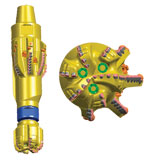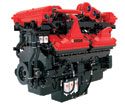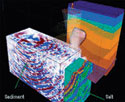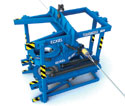
|
Vol. 225 No. 9 |
Geoscience software for open-source platform
Paradigm's new epos 3.0-based product suite is available on the Intel Itanium 2 processor-based SGI Altix system. The latest versions offer complete workflows, from seismic data processing and imaging, through interpretation and visualization, to reservoir characterization, petrophysics, well planning and drilling, in a single environment. The epos 3.0 framework provides seamless application workflows, comprehensive data integration and a unified 3D visualization canvas. The SGI Altix family combines supercomputing architecture with Itanium 2 processors and the Linux operating system. The Altix 3000 platform boasts the combined speed of shared-memory NUMAflex architecture with the Itanium 2 microarchitecture to create an open-source Linux environment with 64-bit scalable architecture.
|
New reamer bit
|
|
| |
 |
Hughes Christensen recently introduced a new version of its drill-out capable ream while drilling tool (RWD2) that improves tool dependability and borehole quality. With conventional tools, the reamer section pushes the pilot bit into the hole wall where it can dig into the wall, causing an oversized pilot hole and off-center rotation. This causes one-sided wear on the pilot bit and an undersized reamed hole. The new design addresses under-gauge hole, hole spiraling, rippling and hour-glassing with a pilot stabilization pad. The pad has provided a much larger reaction area to prevent pilot side cutting. Engineers increased pad diameter so it would be larger than the pilot bit. The larger pad is forced into the smaller pilot hole, providing a tighter fit, decreasing vibration and spiraling and forcing the reaming blades to cut at maximum gauge. The design eliminates shale balling by relocating and re-tilting mud circulation nozzles to optimize bit cleaning and cooling. And an optional ceramic-reinforced and polymer-based bit coating reduces bit balling. Unlike the primary blade of a bi-center bit, which is required to take more than its share of the cutting load, causing abnormal wear, the new technology evenly distributes the depth of cut of all cutters across all blades. Further addressing premature wear, it utilizes longer radius and smooth blade profiles, giving more cutters to the area and reducing high point wear on the sharp blade shoulder area, seen in bi-center bits. Even with these improvements, overall length of the new bits is shorter than some bi-center bits, providing improved steering characteristics.
|
|
|
|
|
|
Expansion joints, rubber products
 Expansion joints, reducers, fittings, elbows, duct work connections, vibration pipe and custom designs are all available from Red Valve through their Redflex line of rubber products. All products are made to the highest quality standards and conform to all FSA guidelines. Parts can be custom-built to compensate for offset flanges, special face-to-face dimensions or unique configurations. Sizes range from 1 in. to 108 in.
Seismic services
Compagnie Generale de Geophysique (CGG) has launched EYE-D, seismic solutions designed to better visualize and understand all the dimensions of hydrocarbon reservoirs to deliver the best seismic data. The EYE-D offering brings together CGG's suite of enhanced seismic solutions for application throughout the life of the reservoir. It is a combination of tools and methodologies offered by the company's commercial teams in land, marine, seabed acquisition and in processing-reservoir. Each seismic project is unique, requiring a tailored response to meet the specific requirements of each client. CGG provides high-resolution, 4D and seabed seismic that differentiates its high-end seismic technology from other alternatives.
Coiled tubing compensation
Schlumberger Oilfield Services announced its new CT TComp coiled tubing total compensation system for offshore. The system protects wellhead integrity during coiled tubing operations by limiting wellhead stresses and compensates for vertical and horizontal wellhead motion inside or outside the derrick. It is faster to rig up than conventional systems and it enables operations on spar platforms and tension leg platforms. Field studies showed that 13 – 16% of the average 87 hours required for the rig-up and rig-down process could be eliminated. The CT TComp system can be used as a motion-compensated jacking frame, a 350-ton tension-lift frame or an internally compensated tension-lift frame. It comes assembled into only three skids: one each for the hydraulic power unit, BOP and injector. The system requires fewer than half the minimum number of lifts required to load conventional equipment onto the platform. BOPs, flow cross, sidewinder, side-door stripper injector, and gooseneck are delivered to the platform preassembled within frames.
High power diesel engines
 Cummins Inc. has introduced its QSK60 diesel engine, featuring a 3,000-hp rating. Developed to meet the high power density and reliability requirements of frac pumping, the 60-liter, V-16 configuration has ferrous cast ductile pistons that allow high fuel injections pressures and increased power output and durability.
3D VSP processing
 VSFusion, a joint venture company formed from the borehole seismic processing groups of Baker Atlas and CGG, has launched their VS3SM system for 3D VSP processing. The system incorporates several components to provide superior imaging capability and rapid 3D VSP survey turnaround time. It brings together 3D survey design through its VECON 2D/3D presurvey modelling software, data pre-processing through CGG's GeoCluster processing system, optimization of the velocity model for improved imaging through 2D and 3D velocity tomography, enhanced imaging through improved migration technology, and full 3D visualization and integration through its VISUS 3D Visualization package. The combination into a seamless, integrated package enables rapid and efficient data turnaround necessary to make VS3 system practical and cost effective for reservoir imaging. The system employs two enhanced migration products to improve the 3D image, CGG's WaveVista anisotropic wave equation migration and 3C/3D vector migration, a method that exploits the full multicomponent information in a 3D VSP dataset to improve the spatial positioning of events in the migration.
Stimulate multiple intervals
FASTFrac Systems, a portfolio of coiled tubing fracture systems developed by Baker Oil Tools to selectively stimulate previously bypassed pay, provides an efficient and economical alternative to conventional stage fracture. Operators can isolate and treat multiple intervals on one trip into the well, cutting workover costs and reducing the total time of completion. The coiled-tubing-conveyed systems optimize production quickly, because kill weight fluid is not needed to contact production intervals, allowing wells to be completed and stimulated live with no need for well kill. FASTFrac tools incorporate an Auto-J system that allows coiled tubing to push or pull the systems into or from a wellbore. Upper and lower packoff elements isolate one or multiple production intervals for treatment. Once the first treatment is completed, the system can be unset and repositioned across another production interval. Both the FASTFrac Packer and Bridge Plug System and the Fixed Straddle System provide operators with an economic technique for stimulating small pockets of gas and oil that used to be left behind.
Remote-controlled torquing
The Conductor Torquing System from BJ Tubular Services offers improved safety and operational efficiency when making up or breaking out conductor-threaded connections. With a spinner system that delivers 7,000 lb/ft, the system is the first of its kind to deliver torques of 150,000 lb/ft, so that conductor connection makeup and breakout, and driving operations, are done more efficiently. It is designed to operate remotely at extremely high torque levels, requiring only one technician to operate the unit from a control unit at a distance from the rotary table. The torquing system and spinner are non-marking systems designed to handle pipe carefully. The makeup system is consolidated into one unit, so that it does not need to be assembled before makeup or breakout.
Automated tong positioning
 The TONGBOSS automated tong-positioning system maneuvers any size Eckel hydraulic power tongs precisely around the tubular during running and pulling operations. The system requires no magnetism, bolting, welding or rig floor tracks. The TONGBOSS never swings freely and is always under full operator control. It aligns the tong consistently with the tubular member, and gives improved cycle time. The system retracts horizontally to a parked location between operations.
|








